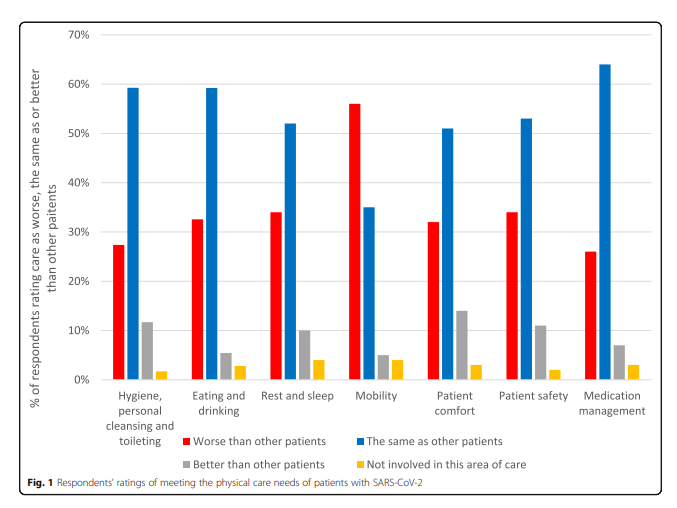
The reviewed article is a mixed-methods study, which utilizes both qualitative and quantitative data in its approach. This approach is self-evident from the methodology section of the study, which describes the survey as the primary method of data collection. Surveys can be used to collect both qualitative and quantitative data. The one presented in the article collects quantitative data about how the nurses rate their own performance, as well as qualitative information in the form of free-text descriptions and clarifications, thus making it a mixed-methods study (Sugg et al., 2021). The type of graph used in the paper and presented above is a bar graph. A bar graph is used to graphically represent categorical data using rectangular bars with spaces in between, which are proportional to the value of representation. A bar graph is a flexible representation tool since the X-axis can represent anything.
The reason why the presented graph is not a histogram is that in most histograms, the X axis has to represent continuous data. The data displayed on the graph on the Y axis includes the percentages of nurses rating their care, which is a percentage distribution. The one at the bottom has explanatory variables, depicting three options to choose from as well as seven overarching groupings. Based on the data provided in the graph, it appears that the percentage of nurses dissatisfied with the care they provide to their patients is around 30% for most areas, except for mobility. In that segment, over 50% of nurses felt they provided suboptimal care to patients (Sugg et al., 2021). Data could have also been displayed utilizing pie graphs and row charts.
A row chart is practically the same as a bar graph only rotated 90 degrees. The advantages of this chart are the same as those of the bar graph, with the exception of a different position. The disadvantages would include looking more cumbersome on the vertical document sheet, which is why it was not used. The pie graph represents data as pieces of a circle, which is well-suited for percentages. However, it also occupies much more space and would have required 7 separate circles to offer the same amount of information. It is the reason why it was likely not used in this paper.
Reference
Sugg, H. V., Russell, A. M., Morgan, L. M., Iles-Smith, H., Richards, D. A., Morley, N., Burnett, S., Cockcroft, E. J., Coon, J. T., Cruickshank, S., Doris, F. E., Hunt, H. A., Kent, M., Logan, P. A., Rafferty, A. M., Shepherd, M. H., Singh, S. J., Tooze S. J. & Whear, R. (2021). Fundamental nursing care in patients with the SARS-CoV-2 virus: Results from the ‘COVID-NURSE’ mixed methods survey into nurses’ experiences of missed care and barriers to care. BMC Nursing, 20(1), 1-17.